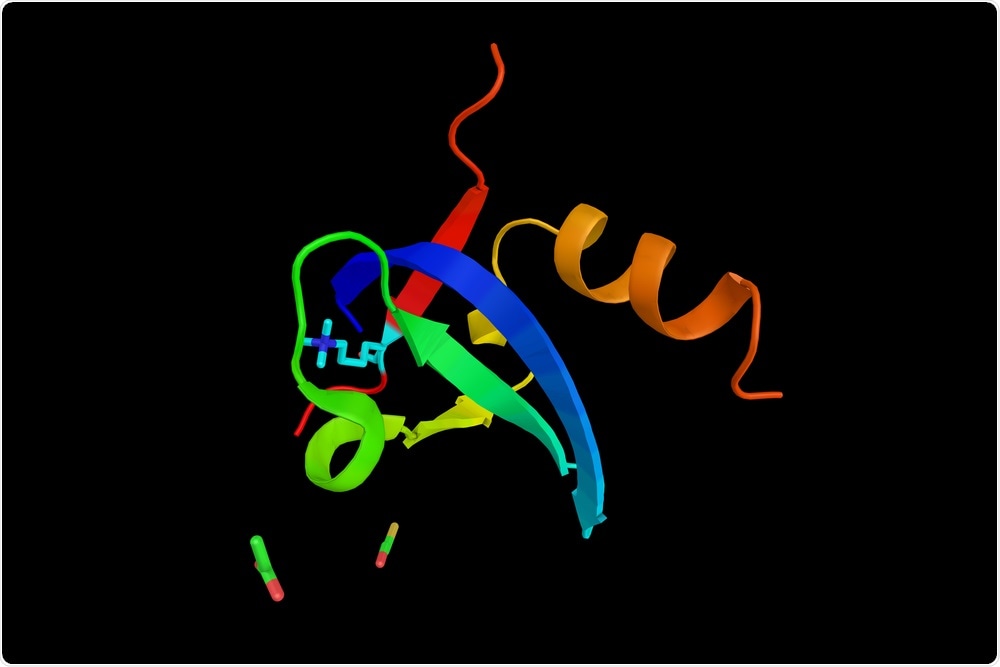Scientists from Massachusetts General Hospital (MGH) have resolved a long-standing debate over how crucial gene-silencing protein detects its targets. The researchers’ findings, published in the Nature Structural and Molecular Biology journal, also describe some secrets about the activity of this protein, called Polycomb repressive complex 2 (PRC2).

Image Credit: ibreakstock/Shutterstock.com
The PRC2 protein helps control whether genes are silent (off) or active (on). The role of PRC2 in gene silencing is crucial during the lifespan, right from the formation of embryos to old age. For instance, the PRC2 protein establishes whether genes that inhibit the growth of malignant tumors are switched on or off, which has made it the focus of pharmaceutical firms designing anti-cancer drugs.
However, an enigma about the PRC2 protein remained unresolved for many years—that is, how was the protein able to target particular genes? Back in 2008, a significant breakthrough happened, when a research team headed by Jeannie Lee, MD, Ph.D., a researcher in the Department of Molecular Biology at MGH, suggested that RNA serves as a recruiter for the PRC2 protein.
Ribonucleic acid (RNA) is a molecule analogous to DNA found in cells. RNA is generally a messenger that does the bidding of DNA by spelling out the code to produce proteins; however, that is not the case here. Instead, Lee and her collaborators showed that RNA serves as a “free agent” that attaches to PRC2. Later, RNA targets the PRC2 protein to a particular gene to silence it.
As soon as Lee and her collaborators reported their findings, scores of other articles were subsequently published that supported the concept that RNA recruits the PRC2 protein as a critical step in gene silencing.
But analyses from many leading laboratories have challenged these discoveries, resulting in ongoing and often-heated discussions about the link between RNA and PRC2. Such critics questioned Lee’s finding on two grounds:
- PRC2 is not specific and can attach to any RNA (some researchers observed that the protein is “promiscuous”), indicating that RNA cannot be a factor in targeting the PRC2 protein for gene silencing.
- The interplay between RNA and PRC2 usually takes place at active genes, indicating that this association is not crucial for silencing particular genes.
Both critiques were resolved by the new study. According to Lee, in the first instance, one can think of the PRC2 protein as a letter that has to be sent by a mail carrier but does not have an address. So, how does the mail carrier know where to send it—that is, what is the actual “address” of the gene to be targeted for silencing?
The address is written on the RNA. RNA is an exact copy of DNA, where our genes are encoded.”
Jeannie Lee, MD, PhD, Investigator, Department of Molecular Biology, Massachusetts General Hospital
Lee and her collaborators detected “motifs,” or exclusive sequences in RNA, which enable it to be detected by the PRC2 protein. The RNA “address” subsequently directs the PRC2 protein to a particular gene site. This possibility was already suggested before, but Lee and her group have now provided a better understanding of how motifs make potential specific interactions between RNA and PRC2 that allow targeting.
Lee employs another analogy to describe why RNA and PRC2 frequently communicate at non-silenced genes. Earlier, light bulbs could only be switched on or off, but the invention of the dimmer switch enabled them to cast a bright or soft light.
Similarly, genes are not invariably switched completely on or off, and the PRC2 protein behaved similar to a dimmer switch.
We are saying that the genes are ‘on,’ but only yielding dim light. If you took away the Polycomb-RNA interaction, the genes would turn up and shine brightly.”
Jeannie Lee, MD, PhD, Investigator, Department of Molecular Biology, Massachusetts General Hospital
By resolving previous disputes over the interaction between PCR2 and RNA, the new unified model advances fundamental science and offers useful insights for developers of new therapeutics, concluded Lee.
Source:
Journal reference:
Rosenberg, M., et al. (2021) Motif-driven interactions between RNA and PRC2 are rheostats that regulate transcription elongation. Nature Structural & Molecular Biology. doi.org/10.1038/s41594-020-00535-9.